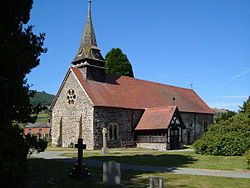Llanfechain
| Llanfechain | |
|---|---|
 St Garmon's Church, Llanfechain |
|
| Llanfechain shown within Powys | |
| Population | 465 (2011) |
| Community |
|
| Principal area | |
| Ceremonial county | |
| Country | Wales |
| Sovereign state | United Kingdom |
| Police | Dyfed-Powys |
| Fire | Mid and West Wales |
| Ambulance | Welsh |
| EU Parliament | Wales |
Llanfechain is a small village and community in northern Powys, mid Wales, between Llanfyllin and Llansantffraid-ym-Mechain on the B4393 road. Historically it was part of Montgomeryshire. Afon Cain runs through the village. It has a population of less than 500.
Llanfechain could mean "parish or church (llan) of the Cain valley" (from Llan ym Mach Cain meaning "church in the field or plain of the Cain" to Llan ym Mechain and then Llan-mechain, which becomes Llanfechain as a result of the common mutation of 'm' to 'f' in Welsh). However, it might also mean "small (fechan) church or parish (llan)". Spellings of placenames vary considerably over time, so small variations such as chain/cain and fechain/fechan are plausible. The name in the form Llanveccheyn is first encountered in 1254. It has also been known as Llanarmon-ym-Mechain,ym-Mechain refers to its location in the medieval cantref of Mechain, thus 'Church of St Garmon in Mechain'.
The parish church, St Garmon's, was originally constructed in Norman times, and still retains many original features. It is a Grade II* listed building It is a single-chambered structure with surviving Romanesque windows in the east wall and two doorways in the south wall. There were some Victorian alterations including the addition of a western bell turret. Inside, the roof dates from the 15th century, the font is from about 1500, the pulpit carries a date of 1636, and at the western end its gallery remains.
Little is known about St Garmon. According to tradition, he lived in the 9th century and preached from a mound in the churchyard at Llanfechain. The remains of this mound, 'Twmpath Garmon' are still evident today north of the church, although graves have been dug into it. According to the recollections of 19th century villagers, recorded in Volume 5 of the Montgomeryshire Collections, cockpits were dug near to the mound for cockfighting. 'Fynnon Garmon', the Holy well associated with Garmon, lies to the south east of the village. St Garmon was most likely St Germanus (410-474), the first Bishop of Man.
...
Wikipedia

